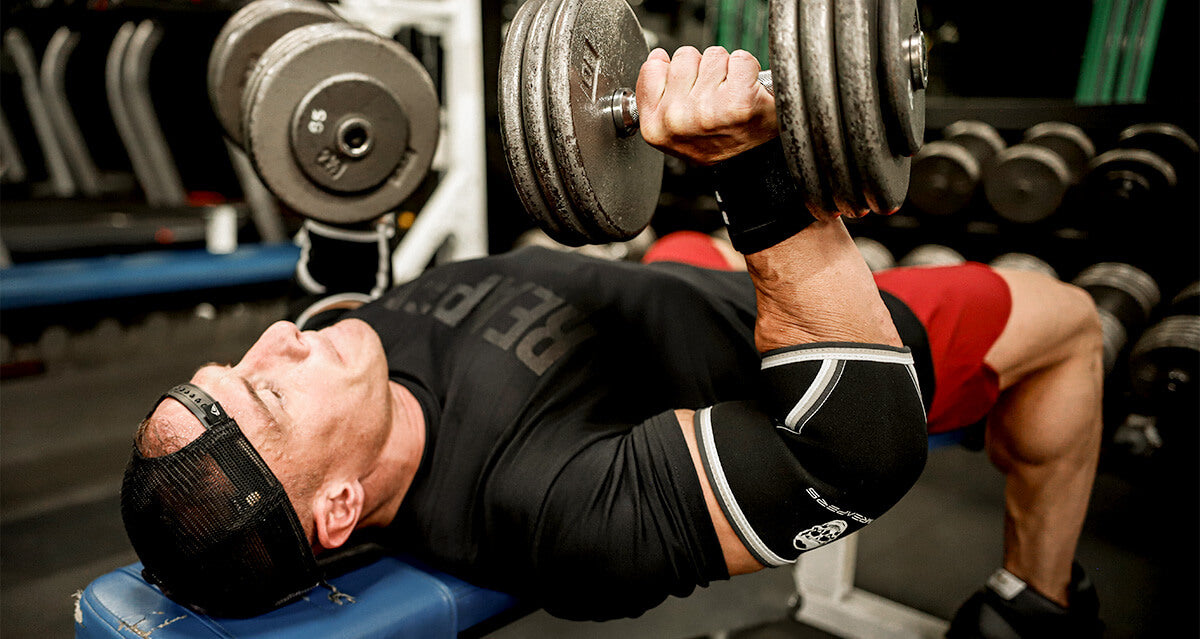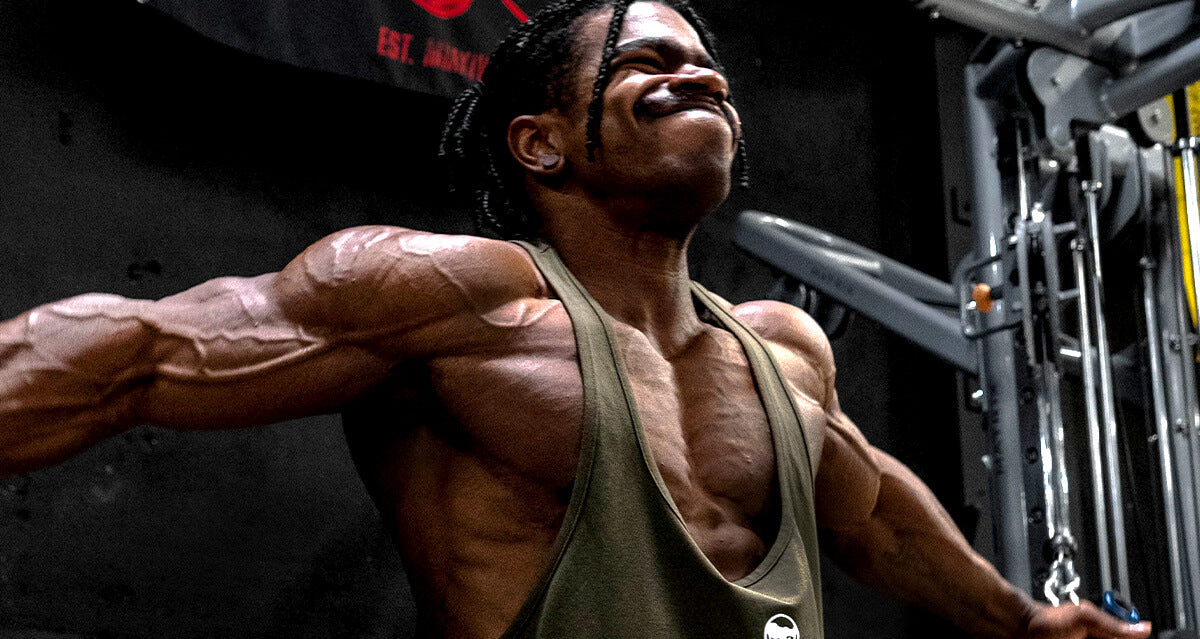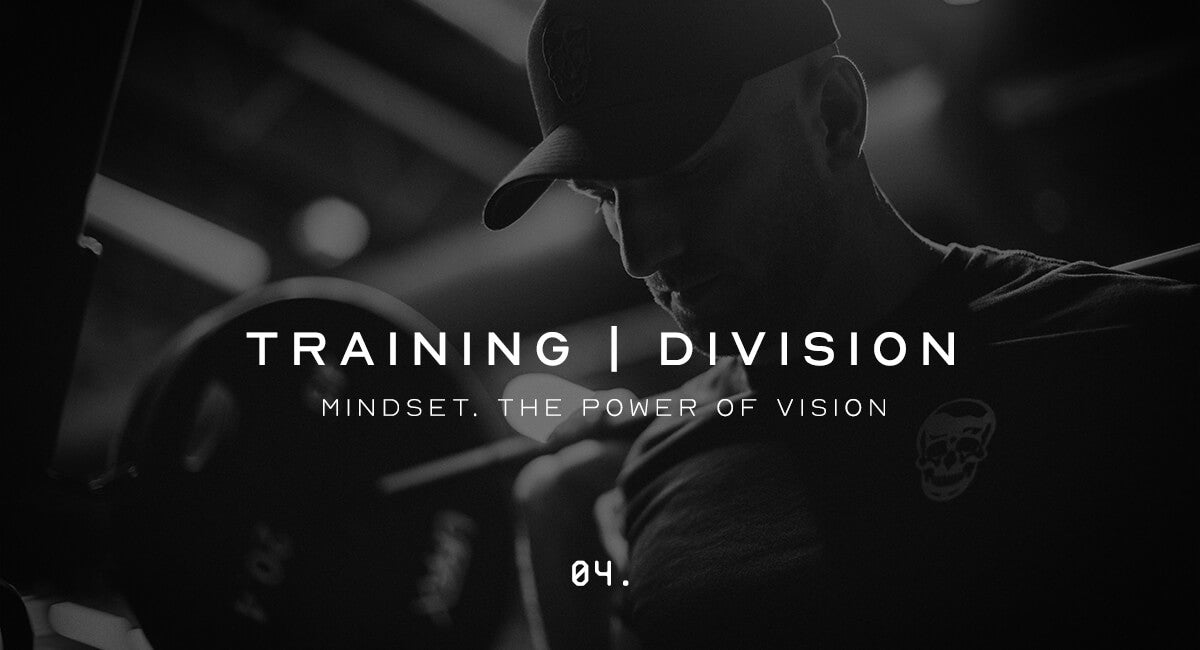Are you struggling to build a bigger chest with dumbbells?
While this is a common issue for many lifters with limited equipment access, there is an easy solution.
I will outline the ten exercises you must do to build a bigger chest with dumbbells, teach you how to do them properly, and integrate them into your workout routine.
Let's dive in.
Key Takeaways
Best Chest Exercises With Dumbbells
Here’s a list of the ten best dumbbell exercises to grow your chest. The list includes compound exercises (1-7), which should be the main focus of your training. The last few exercises (8-10) are isolation exercises, which can help add detail to specific chest areas.
1. Dumbbell Bench Press
A fundamental exercise that targets the entire chest, the flat bench press is an alternative to the barbell flat bench press. This exercise is an excellent alternative as it addresses muscle imbalances and increases the range of motion (stretch) placed on the chest in the bottom position.
If you’re lifting heavy dumbbells, keeping your wrists stable is crucial. Gymreapers’ 18” wrist wraps help by giving you better wrist support, so you can lift more weight without sacrificing your form. This means you’ll lose less force and make your lifts more effective. For a detailed look at the benefits and drawbacks of wrist wraps, check out 3 Wrist Wrap Benefits for Lifting (Plus, 2 Drawbacks).
How To
- Lie on a bench with a dumbbell in each hand, arms extended above you, with your palms facing forward (away from you)
- Lower the weights slowly to the sides of your chest, allowing the front of the shoulder joint to open (rather than hunching forward onto itself).
- Push the dumbbells back up to the starting position and repeat.
Expert Tip: Keep your feet flat on the ground for better stability.
2. Incline Dumbbell Press
The dumbbell incline press focuses more on the muscle fibers of the upper chest. This exercise is a great alternative to the incline chest press (machine) and barbell incline bench press.
To protect your elbows during intense chest workouts, try Gymreapers compression elbow sleeves. They reduce discomfort from issues like tendonitis and arthritis, help regulate body temperature, and enhance recovery by boosting circulation. For more on why elbow sleeves are so popular, check out Why Are Elbow Sleeves So Popular?. Wear Gymreapers elbow sleeves to keep your elbows comfortable and performing at their best.
How To
- Set the bench to a 15, 30, or 45-degree incline, and then sit down with dumbbells resting on the upper chest, palms facing forward (away from your face).
- Press the dumbbells up until your arms are fully extended.
- Lower the dumbbells to the sides of the upper chest, press up to the starting position, and repeat.
Expert Tip: When your arms are fully extended, focus on keeping the dumbbells in line with your upper chest. Pressing them up over your eyes increases shoulder involvement and takes the emphasis off the chest.
3. Decline Dumbbell Press
The decline dumbbell press targets the lower part of the chest muscle fibers and works best at a slight decline (10-15 degrees). You can use a decline bench or place a weight plate, block, or something 2-4” tall under the foot base of a flat bench, which replicates the decline of the barbell bench press.
How To
- Set the bench to a decline position, and lie back with your legs secured to stop you from sliding backward off the bench.
- Press the dumbbells up above your shoulders until your arms are straight.
- Lower the weights until they reach your lower chest, press back up, and repeat.
Expert Tip: Keep tension in your chest and arms in the bottom position to maintain control over the dumbbells and prevent shoulder strain at the bottom of the lift.
4. Neutral Grip Dumbbell Press
The neutral grip press is similar to the above pressing exercises; however, with this variation, you keep your palms facing each other (neutral) the entire time. This change in grip ensures your elbows stay closer to your body and shifts the emphasis to the chest muscles rather than the shoulders.
How To
- Lie on a bench with dumbbells in your hands and your palms facing one another.
- Press the dumbbells up until your arms are fully extended. Keep your palms facing one another.
- Lower the dumbbells to the sides of the chest and press upwards to the starting position.
Expert Tip: Do not let the shoulders collapse or round forward as you lower the dumbbells. Keep your chest proud as if lifting it to meet the dumbbells as you lower them.
5. Chest Squeeze Press
This exercise can help train the inner chest and help you develop a chest split. The key to this exercise is to keep constant tension on the pecs the entire time.
How To
- Lie back on a flat, declined, or slightly inclined bench (15 degrees).
- Hold two dumbbells above your chest, pressing the weights together with your palms facing one another.
- Keep squeezing the dumbbells together as you lower the weights to your chest, then let them separate as you lower them past the chest.
- Press upwards and squeeze the weights together as you press them up, placing them back together as soon as you clear the chest on the way up.
Expert Tip: When lowering the dumbbells to the chest and pressing them up, focus on pressing them together as forcefully as possible.
6. Dumbbell Floor Press
The floor press is a bench press alternative that limits the range of motion. While restricting the range of motion decreases chest involvement, you can use this variation if you do not have access to a bench or want to overload the triceps (improving triceps strength can enhance your chest pressing performance).
How To
- Lie on the floor with dumbbells in hand, with your back, hips, and head on the ground.
- Adjust your elbows to position them 45-70 degrees from your torso.
- Press the weights from the floor directly above your shoulders.
- Lower until your triceps touch the floor, maintaining the same angle as before, and press back up to the starting position.
Expert Tip: If you struggle to feel your chest during these, either go heavier, slow the lowering phase down, or choose the flat dumbbell bench press instead (this will allow a deeper stretched position at the bottom).
7. Dumbbell Reverse Grip Press
This movement emphasizes the chest and triceps by minimizing shoulder involvement. It is a good option for people with shoulder discomfort during regular bench pressing. You can perform the reverse grip press on a decline or flat bench.
How To
- Lie on a bench with a reverse grip on the dumbbells (palms facing you).
- Press the weights above you, keeping the palms facing you and your elbows directly under your wrists (do not let the elbows flare outwards).
- Lower the dumbbells to the sides of the body by pulling your elbows towards the ground, then press up and repeat.
Expert Tip: Use a lighter weight and a slower tempo to keep tension on the chest and ensure your shoulders don’t round forward as you lower the dumbbells.
8. Dumbbell Flat Chest Fly
The flat chest fly is a chest isolation exercise performed using a flat bench. The key to this movement is to get a big stretch at the end range and minimize shoulder involvement as you pull back up.
How To
- Lie on a flat bench with dumbbells above your chest, palms facing each other.
- Slowly open your arms, lowering the weights to the sides while maintaining a slight bend in the elbow.
- Lower the dumbbells until they are even with your torso.
- Bring the dumbbells back together above your chest using your chest muscles.
Expert Tip: If you feel any pinching or discomfort at the shoulder joint when performing this movement, try this variation instead.
9. Incline Dumbbell Flys
Like the flat bench, this is an isolation chest exercise. You can target the upper chest by doing these on a slight incline (15-45 degrees).
How To
- Set the bench to a 15, 30, or 45-degree incline, and sit down with dumbbells above your chest, palms facing each other.
- Perform flys (as described above), ensuring you reach outwards and expand the chest.
- Once the dumbbells reach the bottom of the movement (in line with the shoulders), use your chest to lift them back up to the starting position.
Expert Tip: Focus on feeling the big stretch at the bottom of the movement. If you feel the stretch in the front of the shoulders, you must raise your chest higher (to prevent your chest from collapsing) or stop the movement a bit higher up.
10. Dumbbell Pullover
This isolation exercise works the chest, serratus, and lats. It is all about stretching the muscles, so focus on controlling the lowering phases and using the muscles of the back and chest to lift the weight (not the shoulders or arms).
How To
- Lie perpendicular on a bench, holding a vertical dumbbell above your chest (both hands on the same dumbbell).
- Lower the dumbbell in an arcing motion behind your head by keeping the elbows fixed at a 15-30-degree angle.
- Pull the weight back over your chest using your lats, serratus, and chest.
Expert Tip: Keep your hips down for better isolation and stretch at the bottom of the movement.
How Can You Start Training Your Chest With Dumbbells

Here’s your quick start guide to building a chest workout with dumbbells.
Exercise Selection and Order
For one chest workout, choose 2-4 total exercises, starting with compound movements and ending with isolation exercises.
Compound exercises involving the chest involve movement at the shoulder and elbow joints, such as pressing. Isolation exercises involve movement through only one joint, such as the fly.
You should do compound movements like dumbbell bench press, which require more force and coordination, before isolation movements like dumbbell flys, which require less force.
For example, your chest workout could be structured like this:
- one flat compound press,
- one incline compound press,
- one or two isolation exercises.
Sets
Generally speaking you should train each dumbbell exercise for 2-5 sets.
In the first 1-2 sets, you are often still warming up the movement pattern, reinforcing your technique with heavier loads, and starting to get into the groove of things. The last few sets are where you are zoned in and can push with intensity.
Reps
Aim to train in the 5-10, 10-20, or 20-30 rep range.
If you are pursuing strength, train in the 5-10 rep range, as doing any less than five reps will require you to lift heavier loads and increase the risk of injury.
The risk of injury is higher with dumbbells than with a barbell or machine because getting the dumbbells into position is more challenging and awkward, especially without a spotter.
Training in the 10-30 rep range is also beneficial for muscle growth. This reps range allows you to perform more overall work on the muscle often and place less strain on the joints and connective tissues than training with heavier loads.
Ideally, you train throughout the 5-30 rep range in some capacity throughout the week.
Loading
How heavy you train with dumbbells depends on the rep range you are training in OR the loads you can access.
If you have a large loading selection, lift as heavy as possible for the specific rep range you are training.
For example, if you are training for muscular hypertrophy in the 10-15 rep range, choose a weight as heavy as you can move for 10-15 reps.
If you don’t have a large selection of weights, you may find yourself in a situation where you want to train in the 10-15 rep range but only have access to dumbbells with which you can easily do 25 reps.
In this case, you are better off using your heaviest dumbbells for max reps (exceeding the rep range you initially wanted to train) OR choosing another movement that works better for that rep range (maybe a chest fly rather than a press).
This loading dilemma is one of the most significant drawbacks of dumbbell-only training.
Weekly Progressions
Progressing week to week is critical for strength and muscle growth. With dumbbells, you can progress by doing more reps with the same weight, the same number of reps with additional weight, or the same number of reps and weights but add another set.
Here’s an example of how you can structure your weekly progressions:
- Week 1: Baseline
- Week 2: Add Reps, Same Weight and Sets as Week 1
- Week 3: Add Weight, Same Number of Reps and Sets as Week 2
- Week 4: Increase Weight, Reps, or Sets (Whatever You Can)
- Week 5: Increase Weight, Reps, or Sets (Whatever You Can)
- Week 6: Repeat Baseline Weight, Reps, and Sets
Sample Chest Workout With Dumbbells

Below are two sample workouts. The first is geared towards muscular development (increasing the size and number of muscle fibers).
The second is geared towards increasing strength, which increases the ability of your muscle fibers to produce force, which may or may not also increase the size and number of muscle fibers.
I recommend training both attributes (hypertrophy and strength) in separate phases (each lasting 4-8 weeks).
While handling heavier dumbbells, focusing on wrist stability is essential to avoid injuries. To help protect your wrists as you build your chest, I recommend using Gymreapers 18” wrist wraps. These wraps provide a great mix of functionality and stability and are ideal for training heavy with dumbbells.
Dumbbell Chest Workout for Hypertrophy
For Beginners
- Dumbbell Bench Press: 3-4 sets of 12,10,8,8 reps (ascending loads each set)
- Dumbbell Incline Bench Press: 3-4 sets of 12,10,8,8 reps (ascending loads each set)
- Chest Squeeze Press: 2-3 sets of 15-20 reps
For Advanced Lifters
- Dumbbell Incline Bench Press: 3 sets of 8-10 reps, then build up to a challenging 4-6 rep max set.
- Dumbbell Bench Press: 3-4 sets with the same 4-6 rep max weight used on the last set from the first exercise
- Dumbbell Flat Chest Fly: 3 sets of 8-12 reps, with a 2-second pause at the bottom of every rep.
- Dip or Deficit Push Up: Do a set to failure after every set of chest flys.
Dumbbell Chest Workout for Strength
For Beginners
- Dumbbell Bench Press: 3-4 sets of 5-8 reps (ascending loads each set)
- Dumbbell Incline Bench Press: 3-4 sets of 5-8 reps (ascending loads each set)
- Dumbbell Floor Press: 2-3 sets of 10
For Advanced Lifters
- Dumbbell Incline Bench Press: Build up to a heavy 6 rep max
- Dumbbell Bench Press: 2-3 sets with the same 6 rep max weight used on the last set from the first exercise
- Dumbbell Flat Chest fly: 2-3 sets of 10-15 reps, slow lowering phase
- Dumbbell Pullover: 2-3 sets of 10-15 reps, slow lowering phase
Benefits of Training Your Chest With Dumbbells
The benefits of dumbbell chest workouts are:
Increased Range of Motion
When training with dumbbells, you can go deeper into the bottom position of the press (compared to barbells), allowing you to increase the loading demands on the muscle at its most lengthened position. The bigger the stretch on the muscle (deeper range of motion), the more tension is developed, which can help muscle growth.
Fewer Asymmetries
Unlike barbells and machines, dumbbells allow you to train each arm independently from the other, which helps address any muscular imbalance or movement patterning issues that may not show themselves as much when training with a barbell.
Training with dumbbells can often expose a weaker arm that would otherwise not be addressed because the stronger arm compensates during barbell or machine presses.
Individualized Movement Patterns
Dumbbells allow you to make micro-adjustments to your wrist positioning, elbows, and shoulders as you press, which can both be a blessing and a curse. The fact that your positioning is highly adjustable means you need to work harder to stabilize the movement (which can be challenging for beginners).
It also means you can fine-tune your training to work around joint issues or discomfort.
For example, barbell pressing may add a lot of stress to your wrist; however, you can adjust your wrists (rotating them slightly) using dumbbells to find a more suitable, pain-free wrist position.
No Need For A Spotter
Unlike barbell training, training with dumbbells allows you to bail on a lift when you get stuck at the bottom, which is ideal when you don’t have a spotter to give you a hand.
You’re also limited by how much you can press because they are harder to get into position, so the loads you can lift are likely more manageable.
Frequently Asked Questions
How Often Should I Do Chest Workouts?
You should train your chest twice weekly. This frequency allows you to work the muscles hard, recover for 2-3 days, and then work them hard again. However, if two days a week isn’t producing results, increase it to three times weekly.
Can Dumbbell Workouts Replace Barbell Exercises?
Dumbbells CAN/COULD replace barbells; however, most people do not have access to dumbbells that are heavy enough to continue progressing beyond a certain point. The key is to train the movements as heavily as possible for 5-30 reps, so you will need access to weights that align with this rep range.
How Long Before I See Results?
Assuming you are training your chest hard twice weekly, you will likely see improved workout performance in as little as 3-4 weeks. After 6-8 weeks, you may notice some physical changes in your appearance, depending on your eating habits, leanness, etc. Most people should see results after 8-12 weeks of consistent, hard resistance training.














Leave a comment
All comments are moderated before being published.
This site is protected by hCaptcha and the hCaptcha Privacy Policy and Terms of Service apply.